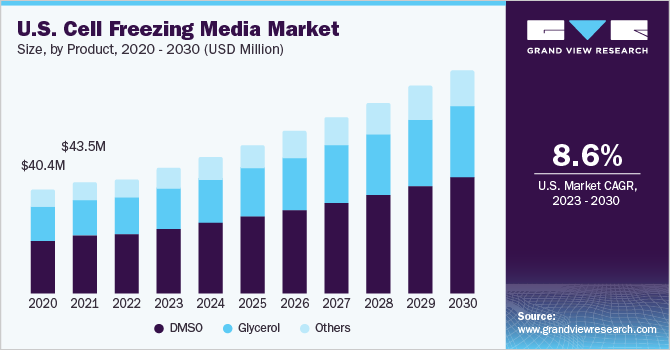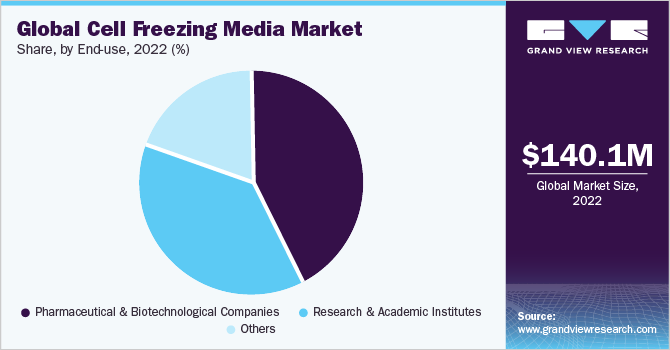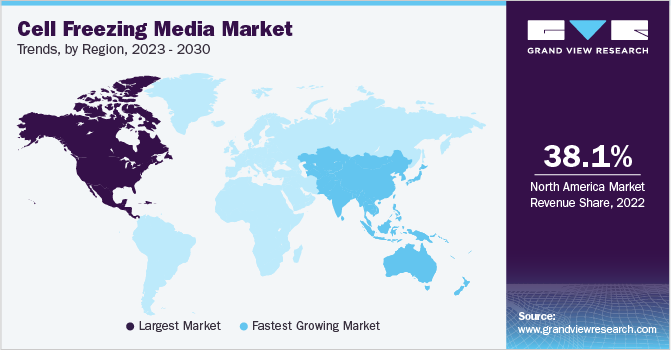- Home
- »
- Biotechnology
- »
-
Cell Freezing Media Market Size, Share, Growth Report 2030GVR Report cover
![Cell Freezing Media Market Size, Share & Trends Report]()
Cell Freezing Media Market Size, Share & Trends Analysis Report By Product (DMSO, Glycerol), By Application (Stem Cell Lines, Cancer Cell Lines), By End-use, By Region, And Segment Forecasts, 2023 - 2030
- Report ID: GVR-4-68040-087-2
- Number of Report Pages: 125
- Format: PDF, Horizon Databook
- Historical Range: 2018 - 2021
- Forecast Period: 2023 - 2030
- Industry: Healthcare
Cell Freezing Media Market Size & Trends
The global cell freezing media market size was valued at USD 140.1 million in 2022 and is expected to grow at a compound annual growth rate (CAGR) of 9.62% from 2023 to 2030. The growth of the market can be attributed to increasing adoption of cell freezing media as an alternative to in-house freezing preparations and the benefits from the ready to use cryo-preservative media over conventional freezing techniques. In addition, rising demand for effective freezing media across wide range of end-users and variety of new products launched from key market players is also anticipated to fuel the market growth.

The market observed a positive impact due to the COVID-19 pandemic. Cryopreservation was the need of hour for vaccine development as multiple stages of processing were involved including the transport between facilities. The need of faster turnaround time with effective solutions from research activities consequently allowed multiple research institutes and biopharmaceutical manufacturers to adopt the ready-to-use freezing media. Additionally, the research and development sector also witnessed increased investments in terms of collaboration, partnerships and expansion which also propels the market growth. For instance, in November 2021, Sartorius invested around USD 31.6 million (EUR 30 million) and launched a new 65,000-square-foot Cell Culture Technology Center in Ulm, Germany, to drive development of cell lines and optimize the company’s cell culture media portfolio.
The industry trend of adopting biopharmaceuticals for disease treatment has also played a major role in expanding the cell freezing media offerings. The flexibility, ready-to-use and cost effectiveness of these media over traditional freezing techniques has allowed their extensive adoption across the end-users. The conventional freezing techniques require handling of liquid nitrogen which involves high safety considerations. Besides this, the risk of cross-contamination, the high running cost and risk of asphyxiation due to displacing of atmospheric oxygen are some of the setbacks of nitrogen usage. Thus, the adoption of ready to use cells freezing media has increased over the past few years.
Moreover, advancements in cell freezing media formulation & cryopreservation techniques, and leveraging applications of cell freezing media in fields like tissue engineering, cellular therapy, stem cells research have driven the market at significant rate. Also, supportive government legislation for regenerative medicine and cell-based research is further projected to support the global market. For instance, in June 2021, researchers from Sydney have received funding from MRFF to pioneer stem cells research for treatment of patients with end stage heart failure.
Product Insights
The DMSO (dimethyl sulfoxide) segment accounted for the largest market share of 51.46% in 2022 and is even expected to witness the fastest growth during 2023-2030. This is due to the established gold standard from years of using DMSO in traditional cryopreservation for suspending the metabolic activities of cells. DMSO is the central player in cryobiology due its aprotic and solvation properties. It inhibits the ice crystal formation both intracellularly and extracellularly at sub-zero temperatures during slow freezing and thus, DMSO has observed widespread adoption as a cryoprotectant due to these antifreeze properties.
Moreover, it even provides protection from biological injuries during the process of cryopreservation. Consequently, multiple market competitors are therefore offering a range of DMSO based cell freezing media among other cell freezing media products. Various applications of DMSO based cell freezing media has also contributed to its largest market share. For example, Merck KGaA via its Sigma Aldrich brand offers multiple DMSO based cryopreservation media which are suitable to use for mammalian cancer cells lines and other cells lines.
Cryoprotective agents like glycerol are also used for cells freezing purpose. Key players are also aligning their cell freezing media products as per the market requirement of various concentrations of CPAs. This allows them to be research inclusive and increase the customer base to bolster the revenue generation. For instance, in March 2021, Thermo Fisher Scientific, Inc. launched a ‘Gibco Human Plasma-like Medium’ that has a metabolic profile similar to that of human plasma. This development has resulted in enhancing the company’s presence in cell culture media space.
Application Insights
The stem cell lines segment held the largest market share of 57.32% in 2022. The growing demand of biopharmaceuticals because of effective treatments like cell and gene therapy and upswing of innovation that resulted in a surge in approvals are the key contributing factors for the segment growth. It is estimated that the U.S. FDA would be approving around 10 to 20 products of cell and gene therapy each year by 2025 due to the current clinical success rates and the product pipeline. This has led the market players to ensure a successful supply network of all consumables considering the hike in demand in upcoming years. As a result, employing cell freezing media for continuous processing of these therapy products will also result in the fastest market penetration within the projected period.
The increasing prevalence of life-threatening diseases and the search for advanced therapies have resulted in intensive research in other areas such as cancer. Cell freezing media has also observed a significant market penetration for cancer cell lines and will grow steadily in the forthcoming years due to continued research activities for better healthcare.
End-use Insights
The pharmaceutical and biotechnological companies segment captured the largest market share of 42.42% in 2022. The continuous growth and commercial success of biopharmaceuticals coupled with the expanding portfolio of the major pharmaceutical companies has been attributed to the segment growth. The optimum protection and preservation by the cell preservation medium along with the cost effectiveness relative to traditional freezing technique has driven its adoption. The unceasing use of these consumables during research stage, clinical and even commercial stages is anticipated to contribute to market growth.

The research and academic institutes segment is expected to be fastest growing segment with a CAGR of 9.9% during 2023 - 2030. This rapid growth can be attributed to the increase in research and development activities in the forecast period. The COVID-19 pandemic has created awareness among the industry professionals along with the need of continuous research and development of existing technologies. The expected growth is also due to huge investment in terms of partnerships and collaboration with research institutes. For instance, NIBRT (National Institute of Bioprocessing Research and Training) announced in May 2022, a collaboration with Kerry Group and ValitaCell to enhance the understanding and validation of cell culture media products for the Kerry Group. ValitaCell will be providing its Chemstress platform for mimicking the biological environment in microscale. This project received funding from Enterprise Ireland to support innovation.
Regional Insights
North America dominated the cell freezing media market with a share of 38.12% in 2022. The market is collectively driven by the presence of advanced healthcare infrastructure, developed economies, presence of key players and established supply channels. Additionally, the prevalence of diseases and growing geriatric population has led to the race of developing advanced and efficacious therapies via biopharmaceutical industry. This has driven the demand for cell freezing media and is expected to continue revenue generation in the years to come.

Asia Pacific is expected to witness the fastest growth with a CAGR of 11.6% during 2023-2030. The Asia Pacific is a region with a supportive government, driven on low labor and operating cost and is a major hub for biologics manufacturing especially monoclonal antibodies (MAbs). The development of MAbs usually employs extensive use of mammalian cell cultures which are continuously processed and require cryopreservation.
Key Companies & Market Share Insights
The key players in the cell freezing media are undertaking various strategic initiatives to maintain their market presence. In addition, various strategic initiatives help market players to bolster their business avenues. For instance, in March 2023, Nucleus Biologics, Center for breakthrough medicines, and Stoic Bio formed strategic collaboration to steady supply of quality-controlled cellular culture medium to facilitate cell and gene therapies development. Such initiatives are anticipated to boost market growth in coming years. Some of the key players in the global cell freezing media market include:
-
Thermo Fisher Scientific, Inc.
-
Merck KGaA
-
Sartorius AG
-
BioLife Solutions, Inc.
-
Bio-Techne
-
HiMedia Laboratories
-
PromoCell GmbH,
-
Capricorn Scientific
-
Cell Applications, Inc.
-
STEMCELL Technologies.
-
AMSBIO
-
Cell Systems
-
BPS Bioscience, Inc.
Cell Freezing Media Market Report Scope
Report Attribute
Details
Market size value in 2023
USD 153.2 million
Revenue forecast in 2030
USD 291.3 million
Growth rate
CAGR of 9.62% from 2023 to 2030
Base year for estimation
2022
Historical data
2018 - 2021
Forecast period
2023 - 2030
Quantitative units
Revenue in USD million, and CAGR from 2023 to 2030
Report coverage
Revenue forecast, company ranking, competitive landscape, growth factors, and trends
Segments covered
Product, application, end-use, region
Regional scope
North America; Europe; Asia Pacific; Latin America; MEA
Country scope
U.S.; Canada; Germany; UK; France; Italy; Spain; Denmark; Sweden; Norway; China; Japan; India; South Korea; Australia; Thailand; Brazil; Mexico, Argentina; South Africa; Saudi Arabia, UAE; Kuwait
Key companies profiled
Thermo Fisher Scientific, Inc.; Merck KgaA; Sartorius AG; BioLife Solutions, Inc.; Bio-Techne, HiMedia Laboratories; PromoCell GmbH; Capricorn Scientific; Cell Applications, Inc.; STEMCELL Technologies.; AMSBIO; Cell Systems; BPS Bioscience, Inc.
Customization scope
Free report customization (equivalent up to 8 analyst’s working days) with purchase. Addition or alteration to country, regional & segment scope.
Pricing and purchase options
Avail customized purchase options to meet your exact research needs. Explore purchase options
Global Cell Freezing Media Market Report Segmentation
This report forecasts revenue growth at global, regional, and country levels and provides an analysis of the latest industry trends in each of the sub-segments from 2018 to 2030. For the purpose of this report, Grand View Research has segmented the global cell freezing media market report on the basis of product, application, end-use, and region:
-
Product Outlook (Revenue, USD Million, 2018 - 2030)
-
DMSO
-
With Serum
-
Without Serum
-
Glycerol
-
With Serum
-
Without Serum
-
Others
-
-
Application Outlook (Revenue, USD Million, 2018 - 2030)
-
Stem Cell lines
-
Cancer Cell Lines
-
Others
-
-
End-use Outlook (Revenue, USD Million, 2018 - 2030)
-
Pharmaceutical and Biotechnological Companies
-
Research & Academic Institutes
-
Others
-
-
Regional Outlook (Revenue, USD Million, 2018 - 2030)
-
North America
-
U.S.
-
Canada
-
-
Europe
-
Germany
-
UK
-
France
-
Italy
-
Spain
-
Denmark
-
Sweden
-
Norway
-
-
Asia Pacific
-
China
-
India
-
Japan
-
South Korea
-
Australia
-
Thailand
-
-
Latin America
-
Brazil
-
Mexico
-
Argentina
-
-
Middle East and Africa (MEA)
-
South Africa
-
Saudi Arabia
-
UAE
-
Kuwait
-
-
Frequently Asked Questions About This Report
b. The global cell freezing media market size was estimated at USD 140.1 million in 2022 and is expected to reach USD 153.2 million in 2023.
b. The global cell freezing media market is expected to grow at a compound annual growth rate of 9.62% from 2023-2030 to reach USD 291.3 million by 2030.
b. DMSO segment captured the largest market share of 51.46% in 2022. This is due to the established golden standard from years of using DMSO in traditional cryopreservation for suspending the metabolic activities of cells.
b. Some key players operating in the cell freezing media market include Thermo Fisher Scientific, Inc., Merck KGaA, Sartorius AG, BioLife Solutions, Inc., Bio-Techne Corporation, HiMedia Laboratories Pvt. Ltd., Miltenyi Biotec, PromoCell GmbH, Caladrius Biosciences, Inc., NIPPON Genetics Europe GmbH, and Capricorn Scientific GmbH.
b. Key factors that are driving the market growth include advantages over traditional cryopreservation, increasing research and development activities, and commercial success of biopharmaceuticals.
Share this report with your colleague or friend.
![gvr icn]()
NEED A CUSTOM REPORT?
We can customize every report - free of charge - including purchasing stand-alone sections or country-level reports, as well as offer affordable discounts for start-ups & universities. Contact us now
![Certified Icon]()
We are GDPR and CCPA compliant! Your transaction & personal information is safe and secure. For more details, please read our privacy policy.
We are committed towards customer satisfaction, and quality service.
"The quality of research they have done for us has been excellent."





